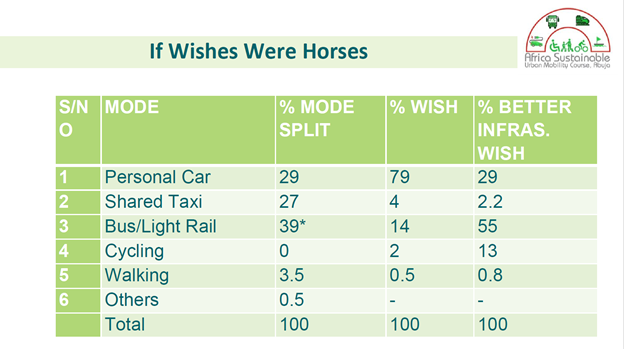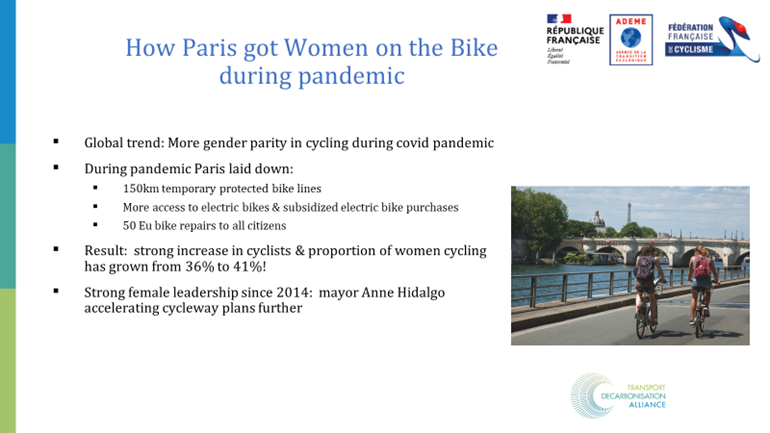This blog was written by Sina Zhen, Sustainable Mobility Officer, ICLEI World Secretariat, with contributions from Yiqian Zhang, Sustainable Mobility Officer, ICLEI World Secretariat
Data from all over the world has shown a lack of gender parity in active mobility such as cycling. However, due to the Covid-19 pandemic, cities across the globe have observed increased popularity of active mobility with bike surge as most visible including women cyclists. In response, cities are starting to make pop-up cycling lanes permanent to attract more people to use active modes. The pandemic has presented a unique opportunity to build infrastructure that promotes sustainability through walking and cycling among women. As we adapt to the new normal, cities may want to ask: How can we maintain the positive momentum of cycling among women in the post-covid era?
In May 2021, ICLEI’s Sustainable Mobility team in partnership with Autonomy Digital hosted a session on “Empowering women through active mobility” where the panelists discussed the barriers and solutions in redesigning and recreating gender-inclusive public spaces for active mobility. The diverse panel of experts provided insights from three regions. This blog will highlight key insights shared during the session.
In India, women are over-represented as pedestrians and under-represented as cyclist
Sonal Shah, Founder of The Urban Catalysts, opened the session with two important questions: 1) In what way is walking and cycling important? and 2) Why should cities conduct gender assessments? Both questions raised important findings regarding active mobility among women in India. Based on research in tier-two and tier-three cities in India, the study found that although women made fewer trips than men overall, they made 1.6 times more trips by walking than men, whereas only making one-fifth as many cycling trips as men. In this sense, we see that women in India are more represented as pedestrians but significantly less represented as cyclists, a trend seen across the Global South. She also shared that women make 61% of all walking trips, making this mode critical in terms of gender-sensitive planning. Hence, it is imperative to find out the barriers in the safety and comfort for women as pedestrians.
On the contrary, of all the cycling trips, only 15% were made by women, showing the need for targeted strategies to increase women’s share of cycling. Sonal also highlighted that it is imperative to also disaggregate the data into age. How many girls are currently cycling and will continue to cycle as adults? What are the barriers preventing girls from cycling?
Removing barriers to active mobility for women in Nigeria
In 1957, a bike was a prize for women in Nigeria but as time passed by, the hype for bikes started to phase out and private vehicles became the new status symbol. What factors affect women walking and cycling in African cities? Emmanuel John, Director of Africa Sustainable Urban Mobility Course and Coordinator for Open Streets Abuja, shared some insights into a gender aggregated survey of urban mobility in Abuja, Nigeria’s capital city. One of the key findings was that 84% of those surveyed who carried two bags were women and 95% of the 119 commuters traveling with children were women. This reaffirms that women and men have different travel patterns and that, women remain as the predominant care provider in many societies, even today.
The study also highlights women as captive users of walking; when asked of their preferred mode choice, only 0.5% of women would prefer to walk. However, if better infrastructure and facilities are provided, the preference for personal car drops, and more women prefer to use public transport and to cycle. Currently, the cycling mode split for women that participated in the survey is 0% but with adequate facility, 13% of women would cycle. This shows that the infrastructure development and policies in Abuja are currently not gender-sensitive, although there are current efforts in policy reforms to change that narrative. One of the solutions presented to the Nigerian government is known as #Love30, asks the government to reduce road speeds to 30kph and to factor in gender in infrastructure design.





